ROAD TEST: RENAULT KWID 1,0 DYNAMIQUE

When Renault announced that a production version of its immensely funky 2014 Kwid concept was on the cards, the decision was no doubt met with nods of approval at the prospect of a city-bound, playful crossover hatch joining the ranks of a resurgent company. It made great sense: offer the lifestyle-oriented little car at a wallet-friendly price that its true target audience, younger, first-time buyers, could actually afford. All of this while undercutting rival offerings by a considerable margin and throwing in some appealing comfort and convenience features not found elsewhere at its price point.

In a market where crossovers are very much the in-thing, it all sounds too good to be true. But, while the Renault Kwid does cover the aesthetic, standard-specification and price bases, something has to give.
There’s a pleasing chunkiness to the Kwid’s styling that, along with a raised ride height and black-plastic wheelarch caps, goes some way to lending it the pseudo-SUV air that’s gained wide appeal of late. But, while the nose, with its snazzy honeycomb grille and neat headlamp arrays, looks fairly upmarket and substantial, the 13-inch wheels appear lost in their wells. And the first concrete sign of the Kwid’s budget roots is evident when you peer into the engine bay to be greeted by reams of hand-applied sealant untidily smeared along most of the sheetmetal seams.
The cabin, meanwhile, initially looks rather promising. It’s trimmed in hard plastics, but their quality and fit are of a good standard for this price point. The standout feature has to be that slick seven-inch touchscreen infotainment system with Bluetooth and sat-nav functionality. It’s included on the Dynamique and a feature that will prove a big drawcard for the youthful, tech-savvy audience at which the Kwid is aimed. It sits alongside other niceties such as electric front windows and an air-con system that is chillingly effective.


But they’re features that are applied to an interior that, in terms of its overall packaging, is rather poorly executed. Anyone of more than medium build will find the passenger compartment a rather pokey environment where scalps graze the headliner and occupants rub shoulders. Conversely, the boot is generous for its class, with 224 dm3 of luggage space expanding to 840 dm3 with the one-piece rear seatback folded. The driver-position ergonomics further frustrate; the seating position is perched, leading to most team members staring at the sun visor, and the fixed steering column either saw the wheel obscuring the instruments or contacting a left knee when the clutch was operated.
Having fired up the thrummy three-pot engine, it becomes clear that these issues are the opener to a driving experience that is unsettled at low-to-moderate speeds and somewhat disconcerting thereafter. Underpinned by the Renault-Nissan-developed CMF-A compact modular platform shared with the Datsun Redi-GO and stretching 2 422 mm from axle to axle, and possessed of the soft, long-travel MacPherson front, torsion-beam rear suspension setup designed for shattered roads, the Kwid’s ride is an odd mixture of choppy at times, occasionally decently damped at others.
Factor in an almost SUV-appropriate 180 mm ride height and a high centre of gravity, and this setup, although benign enough at low speeds, doesn’t take well to brisk directional changes and conspires with numb steering to create the sensation of the car not feeling entirely beneath you. Our tenure with the Kwid was also marked by the presence of the infamous Southeaster whipping across Cape Town. These conditions are challenging for most light cars, but with its combination of flat, high-sided bodywork and a featherlight (695 kg) kerb weight, the wind buffeting that unsettles most cars nearly saw the Kwid drifting out of its lane on several occasions.
Thankfully, that light weight also means that the 999 cm3 engine, with its modest 50 kW and 91 N.m outputs, isn’t overly taxed; thanks to close-set lower gears, it does feel sprightly in town traffic. It also makes the Kwid a frugal little runabout, with our fuel-route run returning just 5,4 L/100 km.
This unit’s maximum torque comes to the fore only above the 4 000 r/min mark, so it does occasionally struggle for overtaking momentum, but once it’s up to speed, the engine feels comfortable enough in maintaining momentum, if a little gruff.


We detected a hint of delay between accelerator input and power delivery that possibly points to throttle calibration which drops the engine’s revs a touch so as not to spin this light car’s tyres when shifting with more gusto than usual, something a couple of us managed to unintentionally do anyway.
But, while motive power was a mixed bag at best, it was the Kwid’s performance in our 10-stop 100-0 km/h emergency-braking test that really opened some eyes, especially those of the hapless tester. Despite a measured foot and some cadence braking, he managed an average stopping time of 3,95 seconds for a resounding “poor" rating. Given the younger, less-skilled drivers at which this car is aimed, we find it astonishing that ABS is neither standard, nor optional.

To review and test a Kwid yourself - test drive the Renault Kwid at a Group 1 Renault dealership near you. Group 1 Renault offers expert and honest advice on all their Renault models.
Article source: http://www.carmag.co.za/road_test/road-test-renault-kwid-10-dynamique/
Posted on January 8th, 2018
New Renault Duster in SA: Revamped, revitalised
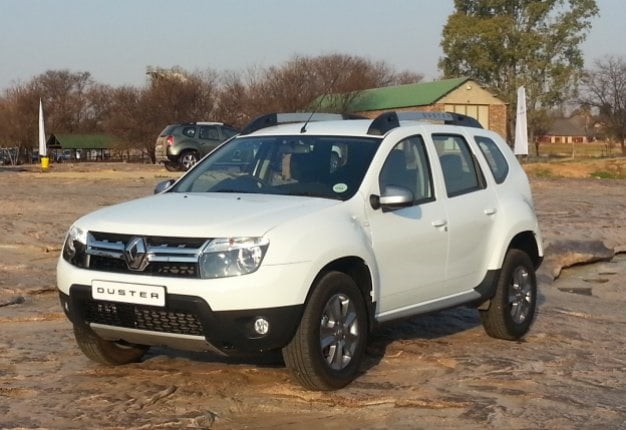
WINNING FORMULA: Renault builds on the local success of it Duster with design and interior tweaks as well as revised diesel engine.
• More than 8000 units sold in SA
• New production factory in Romania
• Revised diesel engine
• Revised exterior and interior
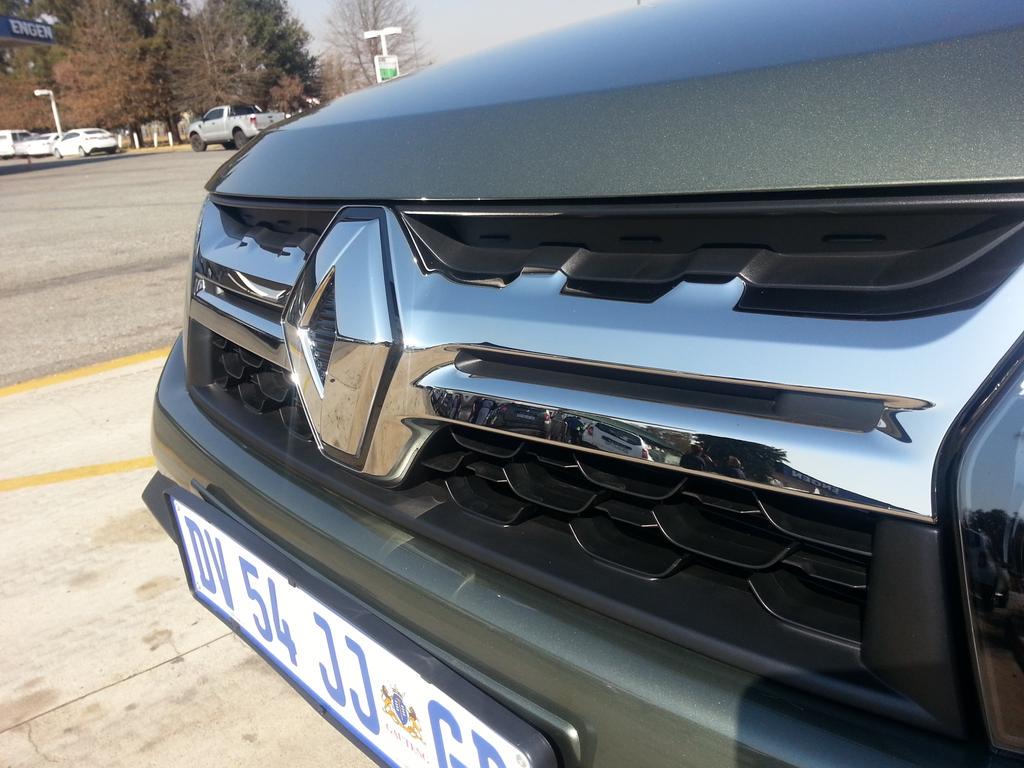
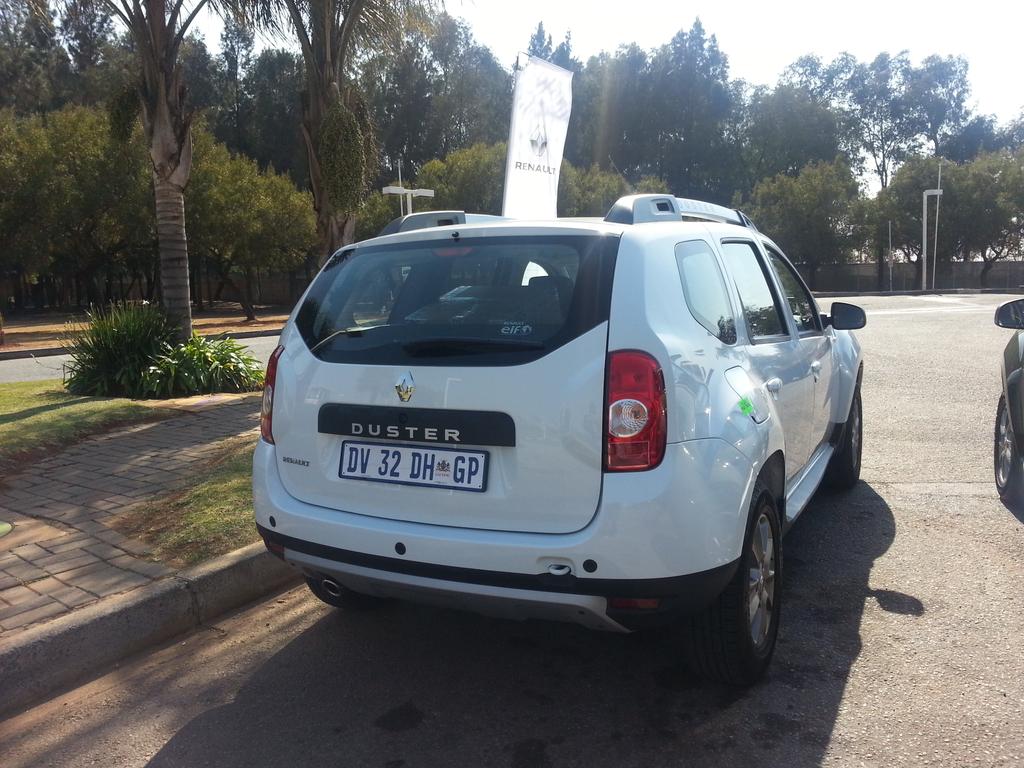
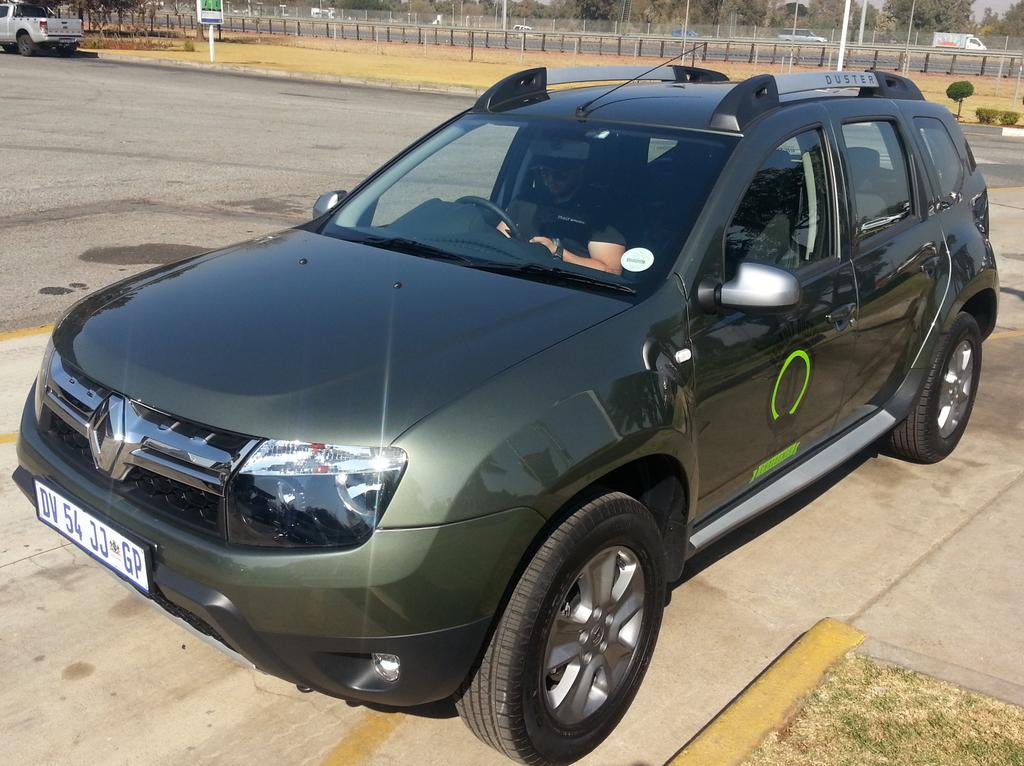
Revamped and revitalised, facelifted Renault Duster has arrived in South Africa. Enhanced inside and out, Renault builds on the local success of its Duster with refreshed styling, new features and improved turbo diesel.
LOCAL SUCCESS
Since its launch in 2013, Renault has sold more than 1.3-million globally and 8000 units locally.
According to Renault: "The first Renault model designed to meet stringent European standards - yet be capable of conquering international markets where usage and road conditions are considerably more rugged - two years down the track, Duster continues to be a formidable contender in South Africa’s B-SUV segment."
IMAGE GALLERY: 2015 Renault Duster
The Duster line-up remains unchanged; two specification levels (expression and dynamique), two engine options (petrol and diesel) and two variants (4x2 and 4x4)
The 1.6 normally aspirated petrol (Expression and Dynamique 4x2) is capable of 75kW/148Nm and is mated to a five-speed manual. Fuel consumption is rated at 7.6 litres/100km with emissions of 181g/km.
The 1.5 dCi turbo diesel engine (Dynamique 4x2 and 4x4 models) is capable of 80kW/240Nm. The revised diesel outperforms its predecessor in terms in terms of fuel efficiency, with a claimed consumption of 4.8 litres/100km (down from 5.5 litres/100km) with emissions of 127g/km (4x2) and 135g/km in 4x4 guise.
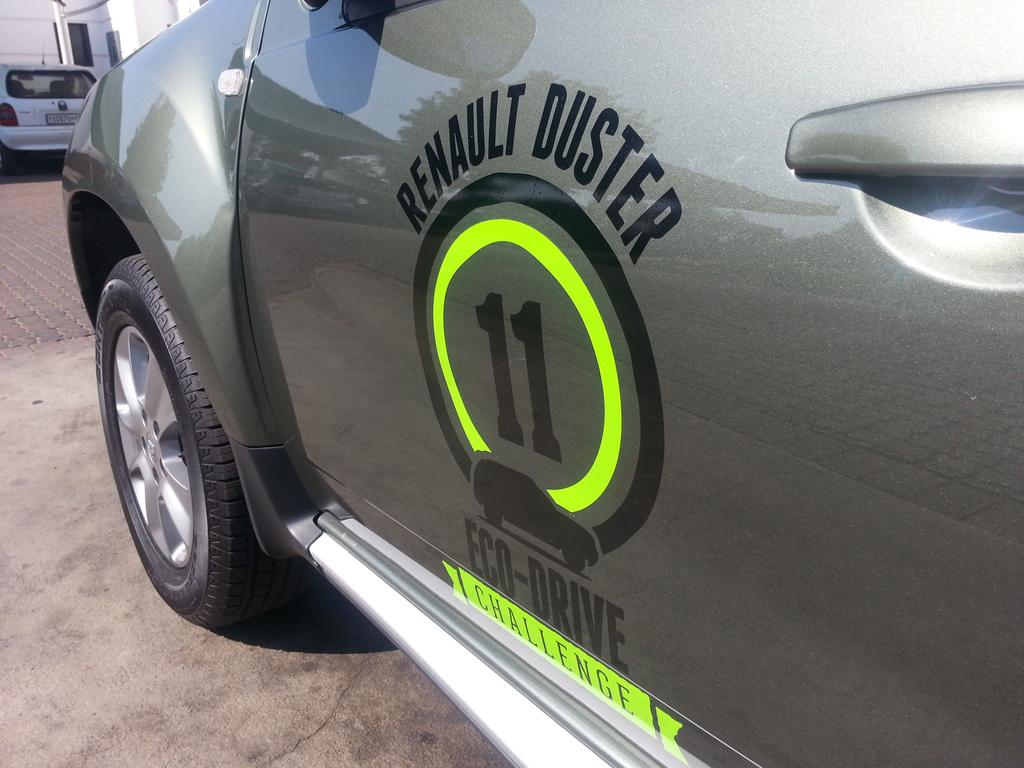
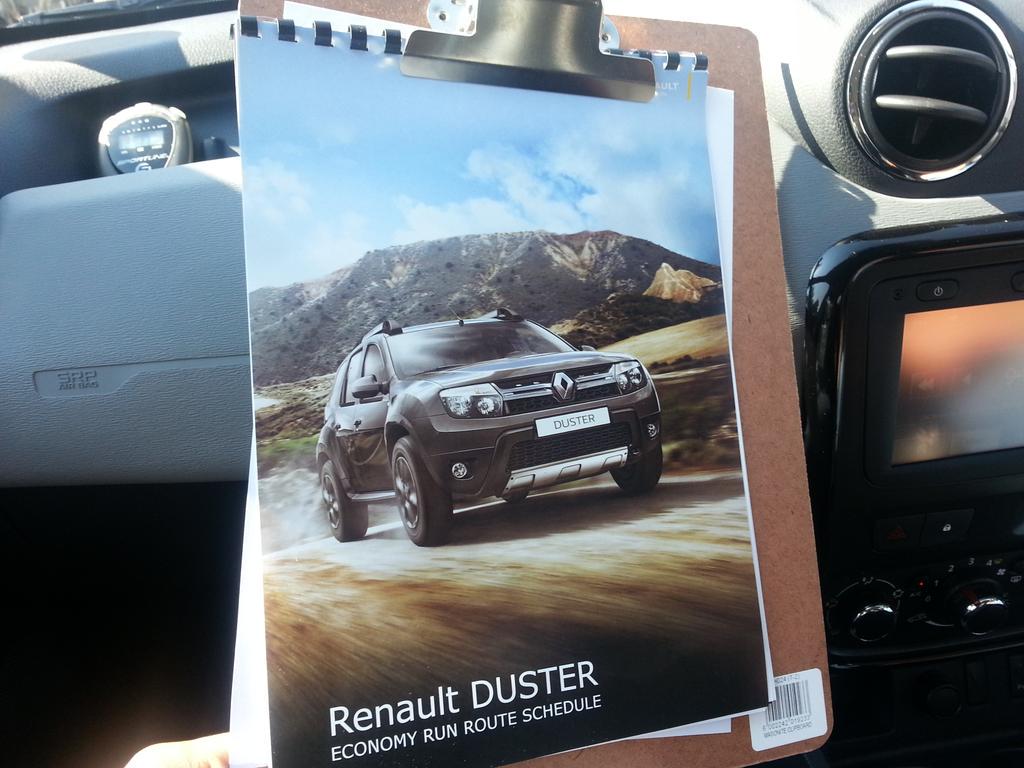
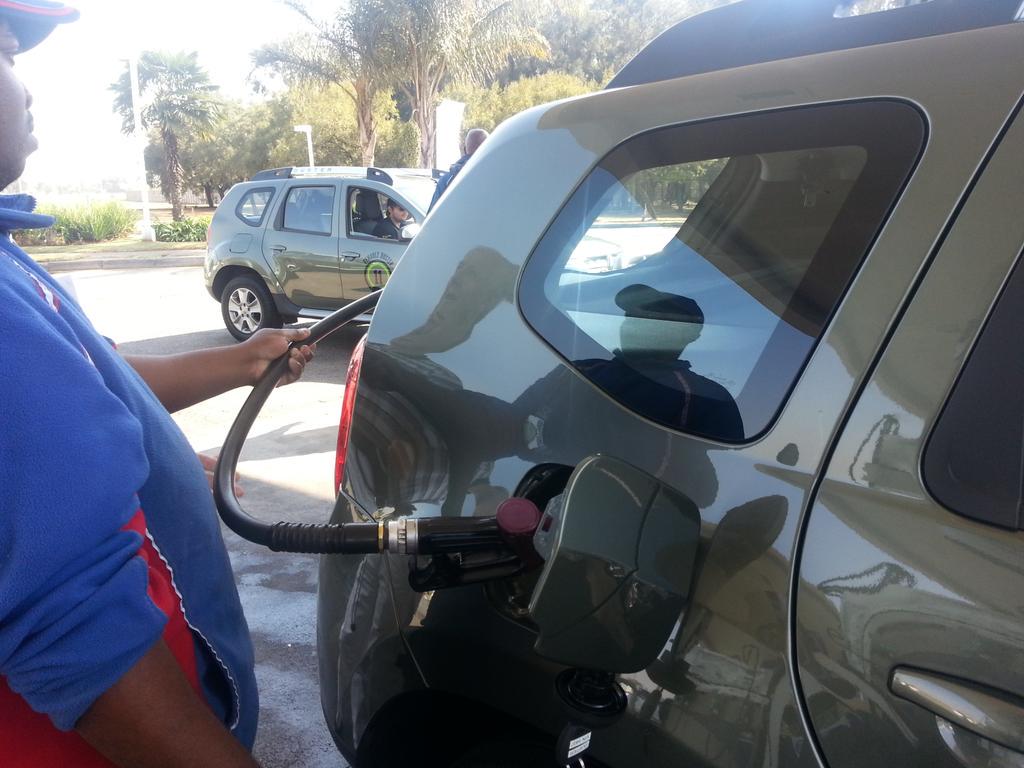
• Two chromed horizontal grille strips (instead of three) and re-designed Renault diamond logo
• Less chromed trim at the front
• New roof bars with Duster moniker etched into the aluminium insets.
• Body coloured side-mirrors
• New alloy rims.
• Parking distance control (standard)
• Patterned fabric replaces plain seat and door panel design.
• 7" touchscreen satnav (Dynamique variants only)
• Cruise control now standard
• Leather trim and seat optional on all three derivatives
HOW FRUGAL IS IT?
Sure the new diesel is refined with, Renault says, reduced consumption but can it walk the talk? Renault SA pitted journalists against each other in its Duster eco challenge (part time-trial, part economy run). In reality, it was more akin to a 300km off-road rally as we took on tar and dirt roads throughout Parys.
During the run I kept an eye on the fuel gauge throughout, while my navigator observed a stopwatch to make sure we reached our check points on time.
I achieved 4.8 litres/100km but due to time penalties was relegated to second place. The winner achieved 5.03 litres/100km without receiving a single penalty.
Overall, an impressive improvement by Renault.
At moderate speeds on smooth surfaces, the ride is adequate and with the addition of slick cruise control for its entry-level units, road trips are made that much more pleasurable.
Renault maintains its Duster is quite adept as an off-roader in 4WD guise. It’s no Land Rover but considering its price and performance the Duster is accomplished off-road.
In terms of practicality it ticks all the right boxes for space and comfort with a spacious boot and plenty of head- and legroom.
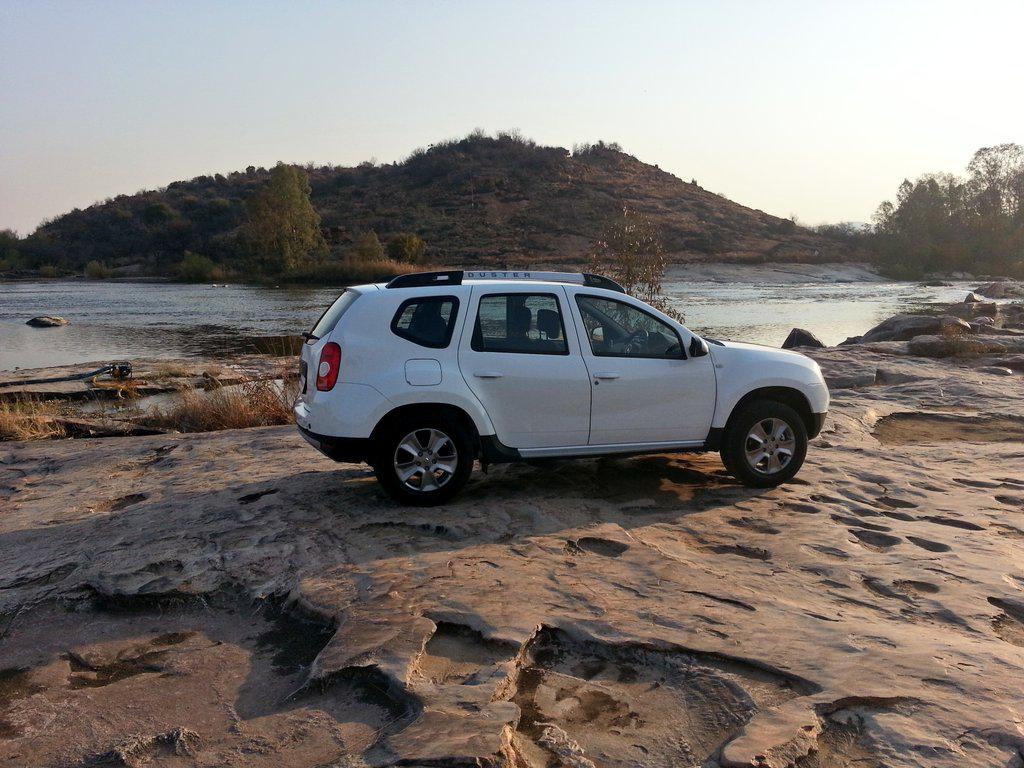
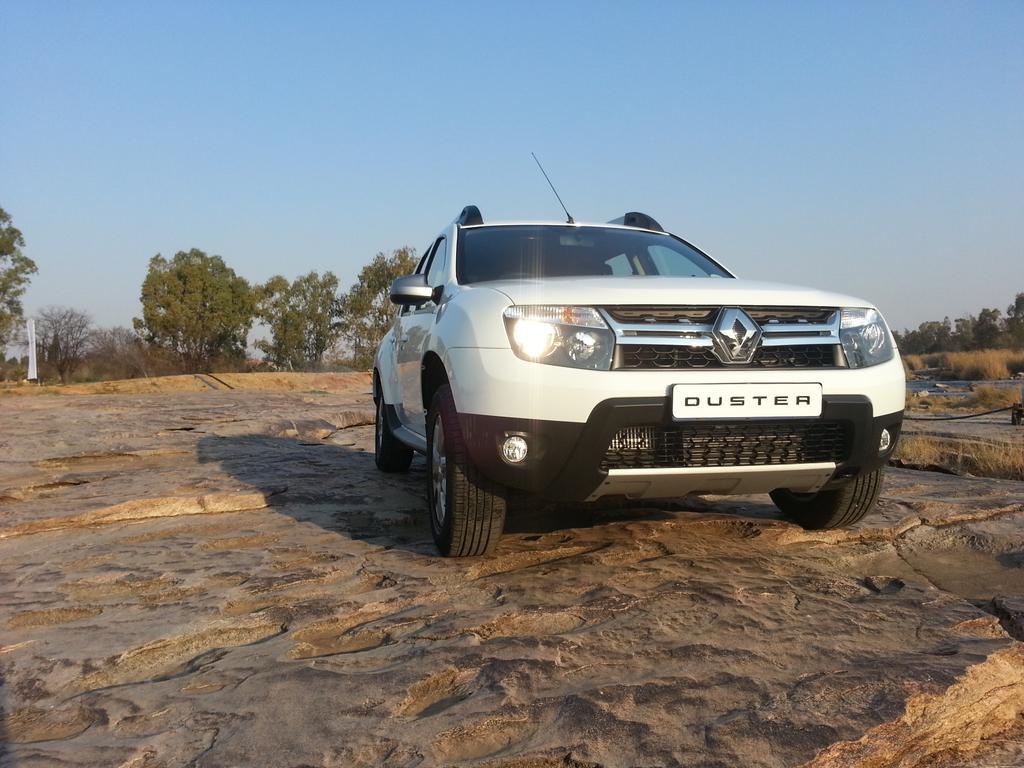
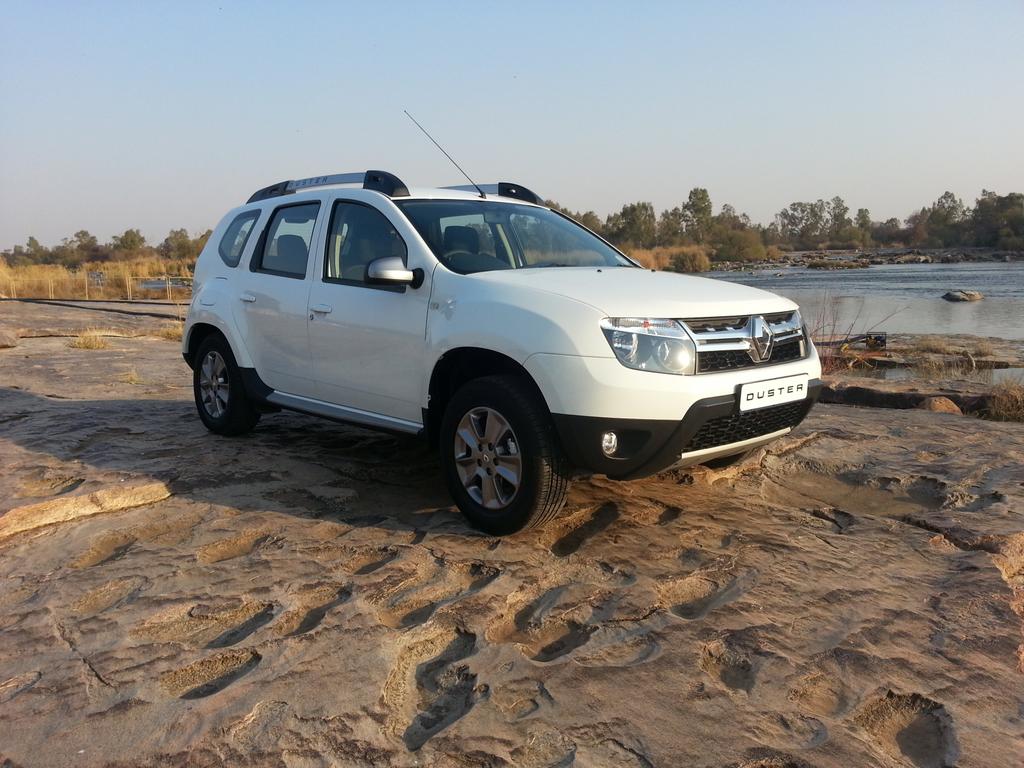
ROMANIAN-BUILT FRENCH SUV
Production of the 2015 Duster has been moved from Chennai, India to Pitesti in Romania and is now manufactured at the same factory as its Sandero sibling.
Product manager at Renault SA Jeffrey Allison said: “Moving production to Pitesti provides us with the opportunity to refresh Duster within a sharper turnaround time - good for the brand and good for our customers here in SA."
OVERALL
The Duster is a bargain compared to other SUVs with similar talents. It’s not perfect but if you’re looking for space and practicality, the Duster could be the car for you. If you're in need of a something more upmarket you could consider the Renault Captur.
The Renault Duster takes on the likes of Nissan Juke and Ford EcoSport in South Africa.
The Duster is sold with a five-year or 150 000km mechanical warranty, a three-year or 45 000km service plan (service intervals at 15 000km) and a six-year anti-corrosion warranty.
Posted on January 8th, 2018
The new Renault Sandero - a Stepway in the right direction
2017 is Renault's best year to date, so far. Its pillar models are doing far better than expected, with the one-airbag, no-ABS Renault KWID in such demand that the French automaker can't keep up.
For February, the comely Renault Sandero was in 7th position overall in the local top ten best-selling passenger vehicle list, less than nine days before the SA launch of the facelifted Sandero even took place. Renault’s February sales figure of 681 Sandero’s reigned supreme over the Datsun Go, as well as the other entry-level contenders such as the Ford Figo and VW Polo Vivo.
I attended the local launch near the Cradle of Humankind last week, and was reminded as to why this little runabout is packing such a punch in the popularity stakes. The new one will undoubtedly be punching even harder. Here’s why:
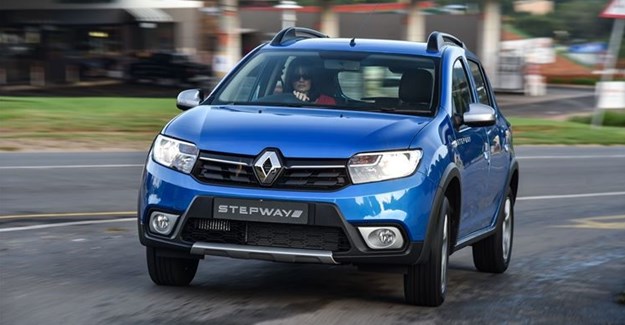
1. It’s a more dapper-looking Frenchman
The outgoing Sandero was sufficiently attractive, but the new Sandero makes more of an urban style statement. All models benefit from a reshaped nose, grille, and headlamps with C-shaped daytime running lamps. Other changes are hard to spot, but the fog lamp housings look different, and at the rear, the tail lamps gain the C-shape as well.
I find the grille design of the entry-level Sandero Expression (R159,900) more attractive than that of the Stepway.
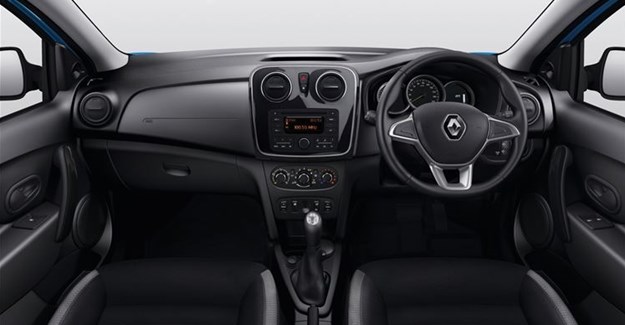
The interior has been upgraded and enhanced, with different trims and a redesigned front fascia. The practical placement of window controls in the doors (instead of on the front console) is also new. The interior is no Audi A1, but for what you’re paying you really shouldn’t complain. Leather seats are a 10K option in the Stepway Dynamique.
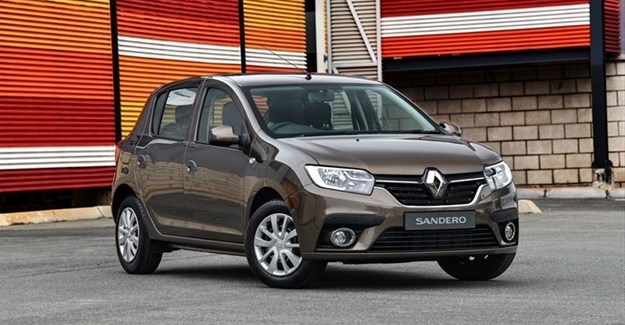
2. You can be counting pennies and still afford an SUV
The Stepway always offered a raised ride height and other outdoorsy details, and since the SUV-lifestyle is all the rage right now, the flagship Sandero Stepway Dynamique cross-hatch is now joined with another Stepway-variant: the more affordable Sandero Stepway Expression.
The Sandero Dynamique hatchback will be falling away completely – Renault found that people would rather buy an entry-level SUV than a more luxuriously-specced Sandero hatch. In the Stepway Dynamique, you can adjust the height of the driver’s seat for maximum visibility up ahead.
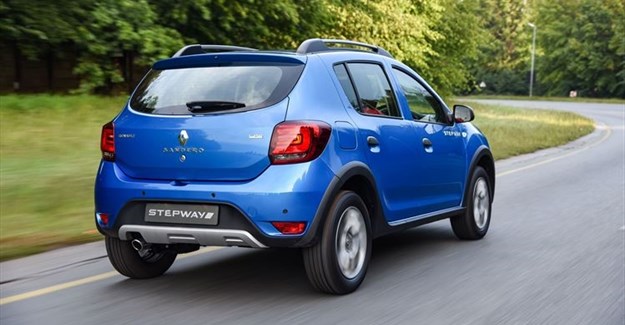
3. It’s loaded with technology unheard of in this price range
The new Stepway Dynamique is kitted out with Renault’s MediaNav 7-inch touchscreen system, featuring integrated navigation. Other creature comforts such as cruise control, rear-park assist and electrically operated door mirrors are thrown in as well. Even the humble Sandero Expression gets a 2-DIN integrated radio CD MP3 with a USB port, Bluetooth telephony and music streaming, fingertip controls, front power windows, and a gearshift indicator as well as Eco Mode.
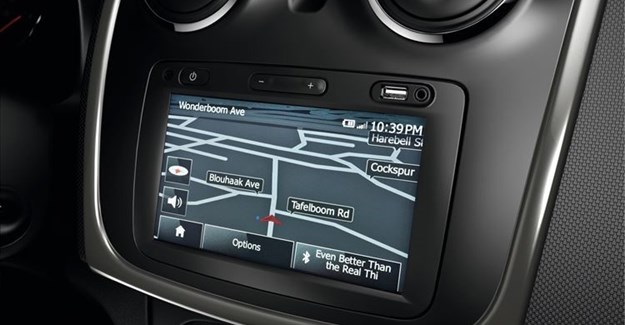
4. Its fuel economy is exemplary
Agreed, the turbocharged 900cc engine is not going to give you a jolt in the backside when you pull away from stop streets, but it’s perfectly sufficient for town as well as open-road driving. Hitting the winding roads of the Magaliesberg proved to be a fun exercise. However, going around a slow corner in first gear is sometimes needed when you think second would have sufficed. You quickly get used to the turbo lag in first and second gear, and you adapt your driving style accordingly. We only spent 180km inside the 66kW Sandero, but it was a relatively vivacious 180km, while our fuel economy returned a fantastic figure of 5.6 litres per 100km.
5. It’s suited to our poorly-maintained roads
The Sandero is loved by rental companies, who prefer their cars to be robust and capable of handling a fair bit of everyday punishment. The 16-inch FLEX wheels that the Stepway-variants are shod with, are especially designed to withstand those pesky potholes.
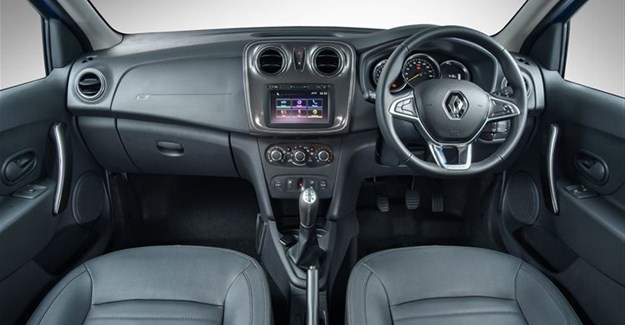
6. It’s the safest car in its class
If you needed one reason to convince someone to go for the Sandero Expression rather than the bestselling, more expensive Polo Vivo, the safety features are it.
In this class, not even ABS is a given, but every Sandero is equipped with ABS as well as EBD and Brake Assist, Hill Start Assist, and (drum roll please!) ESP (Electronic Stability Program) with ASR (Anti-Skid Regulation).
Sandero and Stepway Expression-variants get two airbags, and the Stepway Dynamique gets four. Younger, inexperienced drivers need safer cars, and Renault realises this – let’s hope this way of thinking is continued into the next KWID.
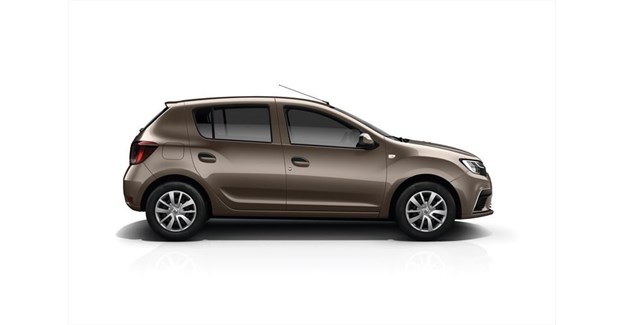
7. After sales service, warranty and service plan
Once again very competitive, beating the VW Polo Vivo, Ford Figo and Toyota Etios with its warranty of five years/150,000km and its two-year/30,000km service plan. Its parts basket is also the lowest of the bunch mentioned above.
Parts availability is no longer an issue since the Nissan/Renault alliance. According to the Kinsey report, the Sandero is also one of the cheapest cars to maintain, service and repair.
Test drive the Renault Sandero today! Visit a Group 1 Renault or view Renault’s range here.
Posted on November 28th, 2017
Renault Captur review 2017
The Renault Captur receives an aesthetic update that, while welcome, does little to keep it ahead of the pack

Back in 2013, when Renault decided to dive headfirst into the booming small SUV market, we were rather taken by its handsome Captur. Based on the sharp-handling Clio hatchback, it quickly established itself as a credible rival to cars such as the innovative Nissan Juke and formidable Skoda Yeti. With a flexible interior, efficient engines and a range of customisable trims, it’s no surprise that it quickly earned the accolade of being Europe's best-selling 'crossover'.
And yet the small SUV market has moved on at a truly startling rate since the Captur arrived, with new models such as the Suzuki Vitara and the larger but similarly priced Skoda Karoq offering a more convincing blend of practicality and performance. Therefore, for 2017, Renault has treated its entry-level SUV to a comprehensive mid-life facelift, in the hope of keeping it competitive for the foreseeable future.
With a great deal of the Captur’s popularly attributable to its adventurous styling, it makes sense that most of the Captur's visual updates revolve around new personalisation options, rather than revised body panels. Up front, a new chrome strip on the grille, as well as new skid plates on the front and rear bumpers help bring the Captur’s styling closer to its bigger sister, the Kadjar, while LED daytime running lights round off its upmarket look.
Unsurprisingly, the 2017 Captur keeps the previous car's recognisable two-tone body colour option, but buyers now get another three colours to choose from, as well as a new roof colour. A fixed glass roof is also available, depending on the trim level you choose. Unfortunately, though, there are no mechanical changes.

What's the 2017 Renault Captur like to drive?
Dynamically, the Captur has never been the most engaging car in its class, and sadly, that hasn’t changed here. On fast and flowing roads, it's nimble enough through the corners, but a shortage of feedback from the steering and a surprising amount of body roll robs the driver of any real enjoyment.
Instead, it’s best to stroke the Captur along at a more relaxed pace. In fact, it’s at low speeds, in an urban environment where this small SUV feels most at home. Renault has made good use of the Captur's increased ride height with its longer suspension travel compared with the Clio its based on allowing for a comfortable ride over ruinous surfaces. Combined with a high-riding, sit-up-and-beg driving position, threading the Captur through tight city streets couldn’t be easier.
Engine options are carried over from the outgoing model, so there's a 0.9-litre petrol, 1.2-litre petrol or 1.5-litre diesel that produce between 89bhp and 118bhp. The latter has a pleasing amount of low down shove, and is a good option if you do lots of motorway miles thanks to its impressive frugality – the Captur pretty much matches the eco-focused diesel Vauxhall Crossland X Ecotech
Blueinjection, with an official combined fuel economy of 76.3mpg, versus the Vauxhall's 76.4. Just be aware that you pay a big premium for a diesel Captur over the reasonably-priced 0.9-litre petrol engine version in the first place.
Ultimately, for private buyers, the 0.9 is the best option. Not only do you benefit from a reasonable entry-level price, but the engine’s power delivery makes the Captur ideal for driving around town, feeling grunty at low revs and far more refined than any of the diesel units. The only downside is that you’re restricted to a manual gearbox, which could be frustrating if you find yourself commuting in heavy traffic.

What's the 2017 Renault Captur like inside?
At first glance, there doesn’t appear to be a huge difference inside, but look closer and you start to notice small yet significant changes. The interior benefits from higher-quality plastics throughout, the steering wheel and gearstick come trimmed with full-grain leather (in our range-topping Signature S Nav trim test car, at least) and the door panels have been reprofiled to give a sleeker appearance.
That said, there is only so much that can be done to lift what is essentially a redesigned Clio. Compared with the Karoq, there’s no doubt that the Captur is starting to show its age both in terms of materials and design. Even the once class-leading R-Link infotainment system - which now comes with Android Auto smartphone mirroring - lacks the responsiveness and clarity of the Volkswagen Group’s latest systems.
Where the Renault still impresses, however, is in its interior flexibility. A sliding rear bench comes as standard, and is particularly useful because it can be adjusted either by those sitting on it, via a lever underneath the seat, or by someone leaning in from the boot, via a lever that protrudes from the seatbacks.
The Captur’s load space is equally practical. There’s a variable-height boot floor on all models, which in its lowest position brings the floor flush with the rear seats when they're folded down - ideal for maximum storage. The boot opening is also of a practical square shape.
Renault Captur review verdict and specs
The Renault Captur receives an aesthetic update that, while welcome, does little to keep it ahead of the pack

Should I buy one?
There is good reason for the Captur being Europe's best-selling small SUV. With a competitive starting price, an attractive aesthetic and a flexible interior, the Captur sticks to the formula well.
And yet this updated-for-2017 model doesn’t feel quite as accomplished as its newer, fresher rivals. The variety of engines on offer feels restrictive, interior quality isn’t quite up there with its best rivals' and the driving experience leaves us slightly cold. A practical, cheap to run small SUV, then, but one that's also a tad underwhelming.
Posted on September 1st, 2017
HOW DUSTY CAN YOU GET A DUSTER?

The term “soft-roader" is widely recognised as the description of a car that has bigger tyres than usual, added ground clearance and some suspension tweaks, but not to the point that it’s as capable off-road as a proper 4x4.
The question is, how far removed from a real off-roader is the average soft-roader? Is the gap between the two really that big, or would a soft-roader get you to some of the places seen as the preserve of the hardcore 4x4s?
We had the opportunity to find out a few months ago, on an epic adventure in Namibia. Renault invited us to drive a Renault Duster through some remote parts of this beautiful country – to a secret location where a film crew was busy shooting a new season of Ultimate Braai Master.
We had previously driven the Duster on our own soft-roader adventure, but on that occasion it had faced little more than a badly corrugated dirt road in the Komatiland Forest. A bad road in Mpumalanga and five days through Namibia’s most hostile terrain are two completely different things, and to be honest, we thought the Namibia trip could do some serious damage to the Duster's reputation.
On our arrival in Windhoek, the Renault dealership wasn’t exactly reassuring. We were told over a cup of coffee that the Dusters we’d be driving were brand new and that the modifications made for the trip had been completed that very morning. So not only were we heading out in vehicles with delivery mileage on them, but we were using untested equipment. The odometer had barely reached double digits, and we faced a five-day drive covering 3000km. At least we could look forward to a 600km section of tar on the final day!
The first leg of our trip was a gravel route from Windhoek to Sossusvlei Desert Camp. These roads are notorious for shredding tyres, so we were surprised to see that the modifications made to our cars did not include a new set of shard rock resistant rubber. In fact, the modifications were limited to a sturdy roof rack and a set of jerry cans in case we couldn’t find 50ppm diesel.
The Namibian version of the Duster includes a stainless steel bull bar as standard, but other than that it was the same Duster we know in SA.

The first 300km turned out to be mostly uneventful. The Duster has a rather rudimentary all-wheel drive system that kicks in automatically when it detects a loss in grip. This made the Duster fairly entertaining on the first leg of the journey, simply because it lets you get the tiniest bit sideways before it intervenes and saves the day. It was loads of fun, but too much of a good thing can lead to a brand new Duster landing on its roof in the middle of nowhere, so we turned off the road to check the tyre pressures. In our hurry to get going, we had forgotten to check this vital element. The car was still set up for city driving and as anyone in the know will tell you, an overinflated tyre and a gravel road really don’t mix. After we had let out some of the air the Duster fell back in line again.
We were missing the sideways action, but had some time to reflect on the Duster’s 1,5-litre turbocharged diesel engine. We have praised this engine before, and it is certainly one of the best currently in production. For its size it delivers a powerful punch, and this allowed us to cruise kilometre after kilometre, without ever having to gear down from fifth.
The hours flew by uneventfully and eventually we pulled up at the Tropic of Capricorn to watch the sun setting over the magnificent Namibian horizon. Our tour guide started getting uncomfortable with our constant picture-taking and loitering, but we regarded this as a wonderful moment that needed to be savoured.
The reason for the guide's scurrying became apparent an hour or so later when we still had 100km or so to drive, without sunlight illuminating the way. The Duster’s headlamps were in working condition, but a moon-free evening in the middle of nowhere is just about as dark as it gets. Couple that with wildlife running around freely and you have a recipe for disaster.
We suppose it was inevitable that one of us would hit something, and we just happened to be in the car when Lady Luck decided to go home for the night. We were in a hurry to get to Sossusvlei and, while driving at 100km/h or so, crossed paths with a frightened young buck. It had simply stared at the first car in convoy, but decided to run across the road a split second before we arrived. There was no time to brake or swerve. The buck died instantly, as did our stupid determination to get to our destination quicker rather than safer.

Surprisingly, the Duster suffered little damage, mostly thanks to the standard Namibian bull bar. The fog light was broken and the bumper was a bit scuffed, but other than that the car was fine.
We eventually arrived at Sossusvlei late at night, thankful for the harsh lesson in mortality. Let’s just say that, in our experience, it’s best not to drive in Namibia after dark.
The next morning we headed for Death Valley. We had seen our itinerary a few weeks earlier and knew that this would be the true test of the Duster’s off-road prowess. You can drive yourself into the desert up to a certain point, but then there’s a large sign stating that only real 4x4s may enter here.
We were in a car with four driven wheels and we weren’t about to give up just because some sign advised us to. It seemed that the previous night’s lesson had been quickly forgotten.
We drove past the sign and got stuck about 300m later! It wasn’t the car’s fault, but rather our own for thinking that we could drive a soft-roader over soft sand in its default auto mode. In sand, momentum is king and the traction control was making anything resembling momentum nigh impossible.
We switched it off immediately, locked the car in all-wheel drive with power distributed 50/50 to the front and rear axles, and set off again. This time we not only kept up our momentum but found ourselves choosing the most difficult path through the soft sand, time and time again.
We made it through, much to the amusement of a large crowd gathered in the 4x4-only parking lot. We explored the area and came back to an entirely new crowd that had gathered around our little 4x4. As it was decorated in “Ultimate Braai Master" livery, most people thought it was a publicity stunt. They wouldn’t believe we had got the car there under its own steam. One guy suggested that Renault had used a helicopter to drop it there. Another wondered aloud whether he had made a mistake in renting an expensive Hilux overlander at the airport. After all, there was a perfectly good Ford Kuga standing at home, but he'd thought a soft-roader wouldn't make it.

By the end of the second day we had proved that you could push a soft-roader much further than you’d expect, but that deduction may be limited to the Duster. After we had driven it for the first time, we expected as much because it is a relatively straightforward, lightweight all-wheel drive crossover.
In the days that followed we kept on driving the Duster into places it really shouldn’t have been. We went to the edge of the Fish River Canyon, through dried riverbanks and over the occasional rocky stretch. On the last day, we even did a 50km off-road track in the hopes of seeing some wild horses.
The Duster got us to the set of Ultimate Braai Master, where we enjoyed plenty of meat and melktert and revelled in the atmosphere of a reality TV show set. (In case you were wondering, the cooking time and elimination process really is as intense as it seems on the screen.)
The trip left us with renewed respect for Renault’s humble little Duster. It started with almost zero kilometres on the clock and by the end we had added 3000 more.
Along the way we lost a fog light and one tyre. That’s the grand total of the damage Namibia could inflict on our French car. It did not develop a rattle, squeak or niggle. The dust did work its way into our luggage in the boot, but this was a small annoyance and something that would probably happen to a hardened 4x4.
Namibia is basically a torture chamber for cars. We often heard stories of how people had rolled their cars, or ruined tyres and been left stranded for days.
On the fourth day, we saw an example of what can happen. We came across a Prado claimed by the desert. It had rolled and burned out – just beyond one of those sneaky corners after a rise in the road.
Namibia is as harsh as it is beautiful, but it turned out to be no match for the Duster.
Find this inspiring? Let the adventure begin and book a test drive in the unconquerable Renault Duster today.
Posted on August 4th, 2017
Renault Megane Review
Renault’s revival continues with a new generation Megane which could reboot the brand's fleet penetration.
The arrival in showrooms of the fourth-generation Renault Megane is one of the brand’s most significant launches following its product and dealer cull back in 2012.
After that low point Renault dealers are enjoying strong sales on the back of the latest Clio and all-new Captur and Kadjar crossovers. However, success in the C-segment is crucial to Renault’s continuing
The new Megane is built on the Renault-Nissan Alliance CLF platform, which also underpins the brand’s other two C-segment contenders: the Kadjar and forthcoming Scenic MPV. Visually the Megane continues the design language of Renault’s most recent launches, in profile being both longer and lower than the outgoing third-generation car, with wider tracks and distinctive edge lighting signatures both front and rear.

Inside, the recipe was, to create a cockpit-like feel, with all controls arranged around the driver, while the most notable element is the 8.7 inch portrait style touchscreen. This is offered as standard from the Dynamic S trim level and allows the easy selection of satellite navigation, audio or car settings without resorting to numerous sub menus.
The Megane also features new technology elements plus the quality finish, cascaded down from Renault’s larger models such as the D-segment Talisman.
This includes the availability of Multi-Sense, which allows owners to personalise a range of elements in the car from the driving modes to the engine sound, interior lighting and even the speed of the climate control fan.
“We will promote the Megane mostly on the technology available across the range," said Megane product manager Yann Le Graet.
Indeed, the advanced technology played a crucial part in Renault’s pre-launch dealer training.
“A highlight of the training was four-control; our rear-wheel-steer system (available on GT models). Dealers were able to experience what it does while they also spent a huge chunk of time learning about the various driver aids. You don’t have to sell such technology because the customer will already know about it, but it is important the dealer knows what it does."
This technology and the availability of the best-selling dCi 110 diesel amongst the initial four-strong engine line-up are also regarded as crucial to rebuilding Renault’s fleet presence, effectively abandoned in the 2012 restructure. Mike Dickens, appointed head of fleet in 2014, has been rolling out a new fleet strategy to the dealer network in readiness for the brand’s new C-segment models.

“Those selling up to 150 units must have a nominated person, who may be a retail salesperson but will receive the same training.
“We are giving the whole network the professionalism to sell the products and effectively doubling our fleet network. We’d taken our foot off the gas in this area in the past because we didn’t have the products coming through."
Renault expects the new Megane will return a 60/40 fleet/retail sales split despite the previous model never making a significant impact in the company car sector.
The brand, however, is less willing to predict future overall volumes for the Megane, arguing that it is difficult to compare likely sales to the launch years of the previous version as the segment has changed so much since.
“It’s a far better car than the Megane 3, a better package that will appeal to a wider audience, and especially the fleet sector – it has improved our credibility," said Le Graet.
Behind the wheel
At first glance the new Megane is far more striking visually than its predecessor, with a low, purposeful stance and bold front-end design emphasised by the edgy signature of the LED lights.

Inside there has certainly been a step up in fit and finish. The seats are comfortable, the controls well-placed. The highlight, however, is the Volvo XC90-style portrait-oriented centre console touch screen, standard on Dynamique S Nav models, an option on lower trims. It’s easy to use and even easier to read.
We drove the dCi110 model expected to both be the range best seller and revive the brand’s fleet presence. It’s a familiar engine, already in the Kadjar, and does not disappoint in this environment, offering excellent levels of refinement whether on urban roads or at speed on motorways.
The steering is light and easy in use, though with not quite enough feel to be as fun to drive as class leaders such as the Ford Focus. But once one includes an impressive standard equipment list, the Megane will certainly find its way onto consideration lists both retail and fleet. Find out more about the Renault Megane in South Africa from a Renault dealership near you.
Posted on July 6th, 2017
10 Things You Should Know About the Renault Kwid
Renault India knew it had to pull a miracle out of its hat if it were to convince people of their seriousness in making a dent in the entry-level compact car segment. Called the Kwid, they managed to do just that, announcing to the world that the smallest baby in their model portfolio pulled punches above its class. We’ve drawn up a list of 10 things you should know about the Renault Kwid, to show you just how distinctive this car is:
10 things you should know about the Renault Kwid
1. The Renault Kwid looks like no other small-car in the history of the Indian automobile. Butch, SUV-esque styling giving it a larger-than-life presence that other cars, many classes above would kill for.
2. The car is built on the CMF-A platform that Renault have developed in conjunction with their Japanese partner, Nissan. The Kwid is the first car to benefit from the platform in India and ushers in a new era in car-building for the manufacturer.
3. Renault have been aggressive on the localization front with the Kwid. This was done with the aim of keeping costs low, translating into the car’s low sticker price that undercuts the competition by a comfortable margin.
4. The Renault Kwid’s mileage is an astounding 25.17 km/l as per ARAI certification. This makes it the most powerful car in the segment, besting the likes of Maruti’s Alto800 and even the Tata Nano.
5. Renault will be launching both, a larger, more powerful 1 litre engine as well as an AMT variant for the Kwid in the coming years.
6. The Renault Kwid’s mileage is not the only thing that’s better than the competition. The car is longer, wider and larger than all other offerings in the segment.
7. Frugal engineering features high on the 10 things you should know about the Renault Kwid. From using three wheel bolts, to a single wiper, the manufacturer has focussed heavily on cost and weight savings. Even the fasteners are lower in number, while plastic has been used extensively to achieve targets.
8. The Renault Kwid has delivered a telling blow with its pricing. With an on-road price that’s a good INR 50,000 lower than the comparable competition, it makes for a compelling buy.
9. The Kwid also has the highest ground clearance in its class, almost putting larger crossovers and even some SUV’s to shame in this department.
10. The Renault Kwid’s interiors are unparalleled, both in terms of the features offered (7-inch touchscreen infotainment system or the long accessories list) as well as sheer space in the boot & the passenger cabin.
All-in-all, the car is a delight on multiple fronts, making it a compelling-buy for someone contemplating a purchase in the segment. To find out more, find a reputable Renault dealership in your area, such as Group 1 Renault.
Posted on January 26th, 2017
Renault Captur Review
by Craig Duff · CarsGuide
What we like
Good value
Secure roadholding and one of the better steering feels in the class
Looks will grab attention
What we don't
No rear side airbags
Two-tone paintjob is significantly more expensive on the Expression
It's all about the look with the Renault Captur, from the optional two-tone exterior styling to the dimpled surfaces, coloured zippers and bright plastic highlights in the cabin.
But there's a method behind the interior-designer madness.
The surfaces will be easy to wipe down, which will endear them to parents with young kids and 20-somethings who tend to live in their vehicles on weekends away. The same applies to the zip-off cushion covers standard in the top-end Dynamique and a $600 option for the Expression.
While the looks will grab the most attention, it's the underpinnings of the Renault that will appeal to diehards used to the brand's hot hatches.
The stiffened suspension definitely puts it at the sporty end of the light SUV brigade. The occasionally jumpy ride is compensated for by secure roadholding and one of the better steering feels in the class. Unfortunately the pace, in either 900cc turbo three-cylinder manual guise or 1.2L turbo four-cylinder auto guise, is at the more moderate end of the scale.
The Captur is destined to be a hit in the same way as the Clio light car it is based on. This baby SUV is a smart mix of stylish looks and decent standard features that justify adding it to the list when shopping for a high-riding crossover.
VALUE
The pricing lands the Captur in the heart of an increasingly competitive segment.
Standard gear includes a seven-inch touchscreen with satnav and a reversing camera, auto lights and wipers, keyless entry and a sliding rear bench seat that can mix and match rear legroom with cargo capacity. With the seats in their most forward position, cargo space is a very impressive 445 litres.
The next step up gets the same interior features but with a six-speed twin-clutch automatic matched to a 1.2-litre four-cylinder.
The Dynamique tops the rangewith a standard two-tone paintjob that's aoption on the Expression, along with fog lights with a cornering function, 17-inch alloy rims and the washable zip-off seat covers.
There are, however, two notable omissions: the Captur doesn't have rear side airbags. Altough, it still gets five stars from the official ANCAP testing regime.
DRIVING
The Captur rides 163mm off the ground and its hip point — the level of the seat squab — is 100mm higher than in a Clio. That makes it easier to get in and out and the doors open wide enough to allow that.
The in-car entertainment is handled by a seven-inch touchscreen with satnav. The graphics are functional if not first rate.There's an enhanced R-Link infotainment system with upgraded sound system for a bit extra, a choice of wheel colours, orange/green/blue interior trim accents and a range of decals. Personalisation is a trend brands are looking to leverage.
Carsguide's first experience is in the triple-cylinder with a five-speed manual box. The sliding rear bench seat means four adults can squeeze into the Renault without needing to dislocate limbs. The back seat position is upright and the pews are flat but the essentials, head, leg and shoulder room, are all catered for.
The ride itself is choppy at urban pace over sharp-ridged bumps and expansion joints, especially in the back where the torsion beam rear end can crash over hits. It handles faster, open roads with shallower ruts with far more decorum.
Momentum has to be maintained on the 0.9L model by regular applications of the gearshift. It's a light throw and the five forward ratios are well spaced to match the rorty, snarly nature of the engine, which effectively winds out of puff at 5000rpm.
Acceleration is acceptable and it rolls easily along the freeway at 110km/h, though overtaking moves would need to be well planned.
The 1.2L is just on a second quicker to 100km/h and feels it both off the mark and during in-gear acceleration. The six-speed dual-clutch auto hesitates off the mark and isn't as crisp on the changes as more advanced models.
It does help keep fuel use down to 5.4L/100km, though on a hard test we saw mid-sevens on both engines.
VERDICT
Differences in design and layout should capture fans for this mini SUV. It has the price, packaging and high-riding position to earn a slice of the fastest growing segment in town.
2015 Renault Captur
Engines: 0.9L turbo three-cylinder, 66kW/135Nm; 1.2L turbo four-cylinder, 88kW/190Nm
Transmissions: 5-speed manual, 6-speed twin-clutch auto
Thirst: 4.9L/100km; 5.4L/100km
Dimensions: 4122mm (L), 1778mm (W) 1566mm (H)
Weight: 1100-1180kg
Spare: Spacesaver
Convinced to get your own? Contact Group 1 Renault and ask about the Renault Captur Price today.
Posted on July 27th, 2016
Renault Captur Review

One of the best (and most distinctive) SUVs for the price.
Wowscore: 7.2
This is the average score given by leading car publications from 10 reviews.
Pros:
Funky styling
Neat, spacious interior
Economical engines
Cons:
Jiggly ride
Some hard cabin plastics
Could be more fun to drive
Review
The Renault Captur is a small SUV that competes with the Ford EcoSport, Vauxhall Mokka and Nissan Juke.
Although it’s very similar to the Renault Clio under the skin, the Captur’s tall body means it has a lot more space. There’s plenty of room up front for adults and the rear seats can slide backwards to give rear passengers more legroom. The Captur’s 450-litre boot is also significantly bigger than the Clio’s. Plastic quality isn’t great, but reflects the Captur’s relatively cheap price.
Aside from its raised driving position, which gives the driver an excellent view of the road ahead, the Captur feels much like the Clio to drive. Its light steering means it is easy to manoeuvre at low speeds, but makes it feel a little nervous in corners – it leans more than the Clio when cornering too.
Petrol engines come in 0.9 and 1.2-litre forms, but the latter’s fitted as standard with an automatic gearbox, which restricts performance and lowers fuel economy. Instead go for the 1.5-litre diesel that can return more than 75mpg and is free to tax.
Kit includes air conditioning, cruise control and a Bluetooth phone connection. Keyless entry is also standard – rare for a car in this price bracket.
Cheapest to buy: 0.9-litre 90 Expression Plus petrol
Cheapest to run: 1.5-litre 90 Dynamique S diesel
Fastest model: 1.2-litre 120 Dynamique S petrol
Most popular: 1.5-litre 110 Dynamique MediaNav
Interior
Roomy and contemporary, but a few last-decade plastics.
Reviewers say the interior is fresh-looking, modern and neat, marred a little by some harder plastics that testers do suggest should be easy to keep clean. Higher-spec models get useful zip-off seat covers (making it ideal if you work outdoors) and generally snazzier cabins. It’s comfortable though, and has a good driving position.
Renault Captur passenger space
A priority for cars like the Captur is space and it does fairly well here. It’s 60mm longer than the Renault Clio that it is based upon so there is space for adults in the back as well as in the front, and rear-seat passenger space can be increased by sliding the seats back on their runners.
Renault Captur boot Space
Those sliding rear seats mean boot space can be increased from 377 to 455 litres as long as you don’t mind sacrificing some legroom. Total boot capacity, with the back seats folded down, peaks at 1,235 litres – 89 litres more than you get in the Clio.
Driving
Like Renaults of old, the Captur is more comfort oriented than it is sporty, but the supermini underpinnings make it an easy car to drive. Light and quick steering makes the Captur feel at home in town, as does its raised ride height that gives the driver a better view of the road ahead.
Out of town the steering’s too light, though, so the Captur seems a little nervous in corners and there’s precious little feel to tell you when it is losing grip. Its soft suspension and tall body sees to it that there’s also quite a lot of body lean, which makes the car feel like it could tip over, although the stability control system will stop this from ever happening.
The Captur usually rides well and feels secure enough on the road, but can be easily unsettled by big bumps and its tyres transmit a lot of noise into the cabin. Trim levels with larger wheels can make the car decidedly jiggly on bumpy roads.
Engine
There are four engine options in the 2016 Renault Captur. Two are dinky petrol units – a three-cylinder 0.9-litre TCe and a 1.2-litre four-cylinder TCe – while the third is the 89hp 1.5-litre dCi turbodiesel that you’ll find in just about any of Renault and Nissan’s smaller offerings. From mid-2015 the Captur was available with a 110hp version of the 1.5-litre diesel too.
Renault Captur diesel engines
Of these, the diesels are best-suited to carting people and stuff around, with a good chunk of low-down torque, a slick gearbox and enough smoothness at cruising speeds. It can get a little noisy though, making the more refined petrols a better choice for a quieter life.
Renault Captur petrol engines
Unfortunately the 118hp 1.2 TCe engine, is combined with a dim-witted dual-clutch auto box that isn’t quite as quick as the best units. It’ll reach 0-62mph in 10.5 seconds though and fuel economy is decent, at 52.3 mpg.
The 89hp 0.9 TCe doesn’t really offer anything to compete with either of the other engines, not matching the diesel’s in-gear performance or 76mpg fuel economy. It’s a lovely little engine, but perhaps not best suited to cars bigger than the Clio.
Safety
An easy five stars, with all the expected gear.
There are six airbags, stability control, hill hold control and emergency brake assist as standard, with three Isofix mountings and anti-whiplash headrests thrown in too. That lot helped the Captur secure a five-star safety rating when it was crash tested by Euro NCAP, although rivals tested after 2013 (when the Renault was evaluated) have been exposed to even tougher testing.
Renault Captur motability
Because of its raised suspension the Renault Captur is easier to get in and out of than a normal car – you don’t have to lower yourself into the driver’s seat and you simply slide off when getting out. The driver’s door is also large and opens wide to give excellent access.
Value for money
Cheap to buy, cheap to run and a good warranty too
Air-con, cruise control and hill-start assist are standard on all Capturs, but Renault’s four-year servicing, warranty and roadside cover package is better than some others offer. It suggests Renault is more confident about its reliability these days, too.
As well as the main trim lines – Expression, Dynamique etc. – Renault also offers a series of American-themed styling packages which lend the Captur much of its character. Called Arizona, Manhattan, Miami and New York, they offer different combinations of exterior colour and gloss and interior features. Your best bet is to raid the Renault website to see which styles you prefer! To help you choose the right shade for your new Captur we have prepared a guide that examines each colour in detail.
Conclusion
The Captur is a talented crossover that’s worthy of its impressive sales figures. It’s a little more carefree and spacious than the Juke or 2008, and cheaper than rivals like the Skoda Yeti, Vauxhall Mokka or MINI Countryman. Slightly bumpy ride aside it drives reasonably too and it’s one of the more stylish options in the class.
Throw in economical engines and a dash of extra practicality compared to the Clio and it comes recommended.
Image source: https://photos-2.carwow.co.uk/models/1600x800/CHR1536.jpg
Posted on July 4th, 2016
Renault Clio Review
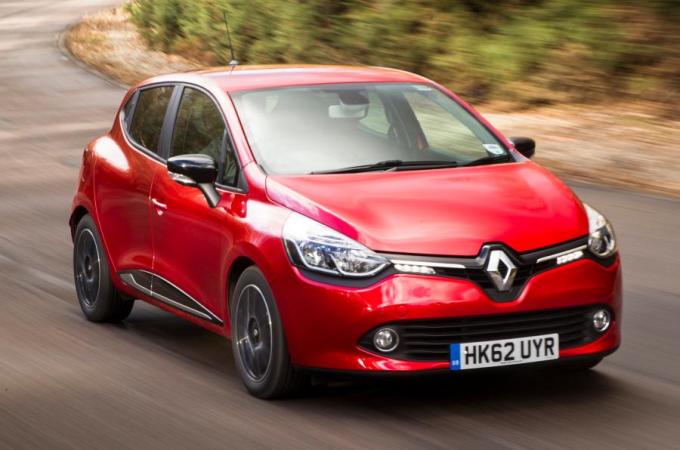
Ever since the late 1940s, Renault’s range has featured an unbroken line of interesting small cars, of which the Clio has been one of the most successful.
More than 12 million have found homes and, along the way, the Clio has found and enjoyed a youthful, vibrant image.
Earlier variants of the Clio deserved that rep, too: being agile, neatly designed, compact, engineered for some dynamism and intelligently marketed.
But – and Renault wasn’t alone in this – during the mid 2000s, when the Clio III arrived, some of that purity was lost. The Clio became bigger and heavier, and went searching – with honourable intent – for more refinement and class, growing up with its customers.
With the extra refinement it found, however, it lost something, as did several of its peers during the past decade. Out went a bit of what Renault used to dub the ‘va-va-voom’.
Which brings us to Clio IV: it’s notably leaner and cleaner than its predecessor. It is also offered with a range of engines, including a frugal 0.9-litre three-cylinder TCe petrol engine and a 1.5-litre dCi diesel, and a decent range of kit.
Question is, has all of that reintroduced some of the joie de vivre? Let’s find out.
First impression? The new Clio is bold, make no mistake. Even though it is sculpted to appear much more lithe than its immediate ancestor, it still looks like a Clio to us. Even, we suspect, were it not wearing a Renault diamond the size of a dinner plate on its nose.
There are differences in proportion, though. Renault has made quite a big play of the fact that the wheelbase is longer than on Clio III (by 14mm, up to 2589mm) but while this is likely to have an effect on handling, it doesn’t help place the wheels closer to each corner, because overall length is up by 30mm.
With that too, though, has come an increase in track, a more steeply raked windscreen and a much lower height: at 1448mm, the latest Clio’s roof sits some 45mm closer to the ground than a Clio III’s.
All of which leaves it looking more dynamic. Renault also reckons that, model for model, the new car is some 100kg lighter than the old one. The Clio III did, in fairness, carry easy pounds to lose, but even so, at this level 100kg is not an amount to be sniffed at.
The range of new engines in the Clio reflects that of its rivals, catering for most tastes and requirements. The entry-level engine is a basic 1.2-litre 16V petrol unit. A modern turbocharged 0.9-litre three-pot TCe petrol is also offered, as well as an 89bhp 1.5-litre dCi diesel.
All versions claim admirable levels of economy and efficiency, particularly if you choose the optional ECO derivatives of the diesel and TCe engines. These emit and consume less than the standard ones, although only by negligible amounts.
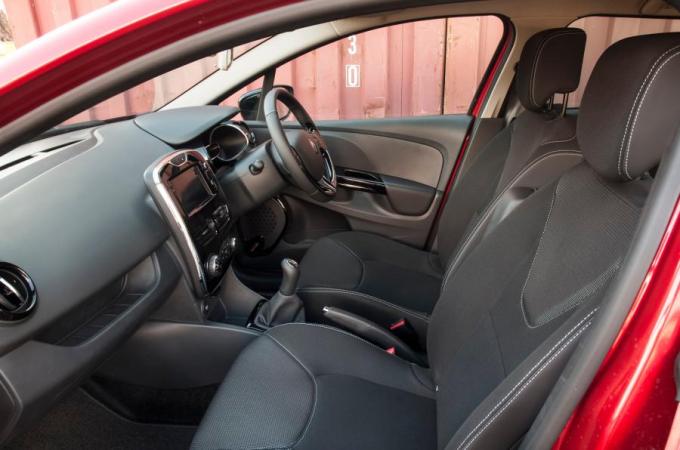
Inside the Clio there's a generous amount of space and the cabin is of a particularly good size. It offers 10 per cent, or a couple of inches, more legroom than you’ll find in the average small hatch, and an inch or so of ‘extra value’ headroom for back seat travellers.
For relatively large adult passengers, in the context of this class, that could make an important difference. We can get on fine with a digital speedo, and appreciate the good-sized indicators and fuel gauge.
There’s the usual quantity of cabin storage but no especially neat or clever packaging solutions. Having added interior space to the Clio with its basic proportions, Renault’s focus was clearly on injecting colour and life into the cabin, and successfully so.
The most conservative choice is a black fascia with black cloth seats, but its attractive sculptural instruments, complemented by lots of gloss black and chrome accenting, lends it an air of technical style and sophistication.
Consumer electronics are an obvious inspiration here, just as they were for the Ford Fiesta. The difference is that, while the Ford’s cabin could have been penned by graduates from Nokia and Motorola, the Renault’s is one of the converged touchscreen design generation, with clearer nods to the likes of Apple, Samsung and HTC.
In terms of function, however, Renault’s R-link system needs some refinement. Postcode entry is still woefully limited, while map graphics on the satellite-navigation system look like they’re from a 1990’s games console, not a contemporary mass-market hatchback.
Material quality levels are fine, but again they don’t quite match that level of ambition. Most of the Clio’s background cabin plastics are ordinary in their look and feel. One or two loose, creaky trims even serve to remind us of Renault’s chequered track record on fit and finish.
There’s also a certain lack of attention to ergonomic detail. The engine start-stop button’s on the wrong side of the centre stack for right-hand drive, for example, and the cruise control button is in an unintuitive position by the handbrake.
Both peculiarities will be familiar to Renault owners, but on such an important car where progress has been made in other directions, this feels like a missed opportunity to remedy them.
There are three engine choices for the Clio. Buyers can pick from a basic 74bhp 1.2-litre, four-cylinder petrol engine, a more powerful turbocharged three-cylinder TCe petrol or an 89bhp 1.5-litre turbodiesel.
The mid-range engine option is a TCe unit, the conceit being that you’re getting 1.4-litre performance with greatly reduced fuel consumption, but that’s potentially a little misleading. We have, after all, tested other superminis of a similar displacement that are both faster and more efficient.
Nevertheless, it’s a good engine. Quiet, refined and responsive, its light-pressure delivery suits the Renault right down to the ground. The engine only really feels turbocharged at very low revs, otherwise it pulls cleanly and with stoutness through the mid-range while holding onto its power at high revs. it's also particularly smooth throughout. Ford’s EcoBoost triple may be more powerful, but it can’t match this Clio’s lack of noise and vibration.
The diesel engine is the more mature choice. It feels quicker than the figures suggest and it’s so quiet and refined that you’d struggle to tell it’s a diesel. Pleasantly, it’s also a tractable engine with a wide torque band, so you don’t have to work the gearbox as hard as you would in the petrol versions.
Admittedly the diesel does add 62kg to the kerb weight of the petrol model, leading to it feeling slightly less agile as a result. Those interested in maximum enjoyment should, consequently, stick to the zesty TCe option. There’s also a 1.2-litre engine carried over from the old model, producing 74bhp and 79lb ft of torque.
In all versions, the shift quality is light but well defined, and brake pedal feel is good. Overall, the Clio is an entirely pleasant device, peppy at times and quite suave at others, with the flexibility and polish to take mixed daily motoring duties in its stride, from motorway miles to cross-country backroads and the urban sprawl.
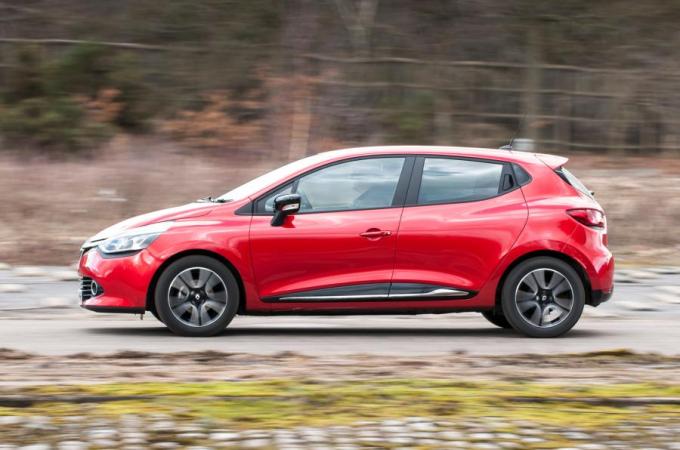
The Clio habitually ranks at the sharp end of the class in this regard. It has never been short on verve, even at the cheaper end of the model scale. But for the Ford Fiesta, you’d probably call it the finest example of the zesty, engaging European small hatch – the sort that the Japanese, Koreans and now the Chinese have been seeking to reproduce for the past 30 years.
But the new one sets higher standards than its immediate forebear right across the board, from compliance to high-speed stability to ultimate grip and amusement value. As a driving machine it’s the most multi-talented and complete supermini to come out of France in a long time: certainly since the Citroën DS3 in 2009, and probably for a lot longer.
The way the Clio segues from remarkable rolling comfort at one moment to slick and engaging handling accuracy the next, marks it out as a work of real class. It’s a calmer customer than the Fiesta; slightly softer of spring and less tautly damped, its low speed ride is very quiet but also more absorptive than the Ford’s.
This means that, at higher speeds, there’s a little more body movement in the Clio. But when that does materialise, and the road surface conspires to test the Renault’s mettle, excellent damper tuning and first-rate bump isolation combine to produce fluent body control and an unusually silken ride in one so small.
Indeed, on an urban test route the Renault feels well refined and able to glide over road defects in a manner more normally suited to a much larger car.
The steering wheel is quite large and it feels a little over-assisted at low speeds. But as you accelerate, so that power assistance ramps down. Ultimately, it allows a well paced, well weighted system to present that, although it isn’t very informative, does feel natural, if a little light in places.
Lean on the suspension and it firms up in trustworthy proportion, keeping control of the body and working the tyres just hard enough to produce plenty of grip and a consistent steering response.
An effective balance of dynamic virtues is what we look for in a good-handling hatchback, and the Clio’s balance of comfort and sporting brio is every bit as striking as its chic new clothes.
Renault has taken a deliberate step forwards with the new Clio; one that the car-buying public and rest of the car industry can’t fail to notice.
This pretty five-door is a statement of intent from a company keen to inject much-needed style, personality, usability and dynamism into its showrooms; it’s a blow landed on behalf of beleaguered Europe in a market where the far eastern powers have been making most of the gains of late. And it’s a resounding piece of work.
The Verdict:
Positives
- Distinctive styling
- Sophisticated ride and handling
- Good-sized, attractive cabin
Negatives
- Undistinguished performance
- Average interior finish
- Unremarkable economy from petrol models
Posted on June 30th, 2016

